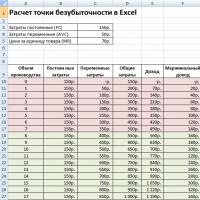How to write a business plan - step-by-step instructions from a real entrepreneur + a sample with calculations and 40 ready-made examples
I know a lot about business planning. Planned and opened 3 family businesses. Drafted 4 business plans for grants and one subsidy from the Employment Center. Helped a few friends formulate their ideas, edited dozens of documents for clients, reviewed hundreds of submissions from business loan applicants.
For two years I worked in a credit institution that financed a business. Beginners and experienced entrepreneurs applied for funds, and we assessed the prospects and payback of the idea, drew up a business plan or corrected the client's existing calculations. Information about the applicant was presented at a meeting of the credit committee, where they collectively made a decision to issue the requested amount or to refuse.
In order to convince all loan officers to vote “yes” for financing, it was necessary to analyze all the possible risks of the project and find solutions for any situation, protect the lender’s money from all sides, and provide exit options if everything goes according to a negative scenario.
The discussion of business projects at the credit committee was structured as follows:
- And what if he divorces his wife, who will sell in his store, because now she herself is behind the counter?
- Hire a second salesperson. By the way, for a loan, the wife acts as a guarantor, so she will take on half of the debt during a divorce.
- What will happen to the debt when the “off season” for sales comes?
– In the off-season, in the schedule, I propose to reduce monthly payments so that the client “pulls” this amount during a period of reduced profits.
“And if his warehouse is robbed?”
“The warehouse is guarded, but we still insure the inventory – this insurance company pays out a refund within a couple of weeks without quibbles and delays, so the client will quickly recover the losses and be able to order a new batch of goods.
Become such a strict commission for your own project and go through all the weak points of the business to find a plan B and C for any situation. Discuss the idea and brainstorm with friends. It is better to find possible problems and think over their solutions on paper even before opening a company than to take risks and incur unnecessary costs later.
Quite everyday situations can turn into a disaster for a micro business and problems for a large enterprise. Take this into account when planning so that you don’t suddenly go into the negative.
My experience will help you draw up a business plan and get funding for it. It can be used to approach private investors, apply for a bank loan, or apply for a grant for start-up entrepreneurs from the local government.
Using the example of my new family business - a small blacksmith shop - I will show you how to create a business plan to raise funds from the budget.
A business plan is a document that comprehensively describes the idea, project, work and results of such work. It takes into account everything from the launch schedule and recruitment to different development scenarios and payback periods. The full version of the document lists possible risks and options for minimizing them.
What is the difference from TEO?
A feasibility study is a feasibility study for launching a project. The calculations in it relate only to the necessary investments, upcoming costs, expected income, payback period. It calculates the financial benefit from the planned activities. A feasibility study can be drawn up when a separate issue is being resolved, for example, about transferring accounting to.
A business plan, compared to a feasibility study, covers a wider range of issues, including promotion and marketing of the project, organizational measures, and risk assessment. The social component of a startup is also considered here. A business plan is a more comprehensive document; it is needed when opening a restaurant or store.
Why do you need a business plan
The business plan shows the seriousness of the entrepreneur's intentions and the depth of his immersion in the topic. He needs this himself in order to understand what awaits in the process, how to avoid problems and make a profit.
But this document is most important when raising funds. Without a business plan, an investor, loan officer or administration employee will not discuss the possibility of issuing loans or budgetary funds.
Let's go back to our forge. My husband and I need a business plan for internal use - in order to understand what launch costs will be needed, how much and what will have to be purchased, what and how to arrange for legal work, what income is possible, what to produce and how to sell.
But another purpose of compiling a BP is to apply for a grant. At the district level, budgetary funds are distributed to support start-up entrepreneurs. It is possible to receive up to 300,000 rubles free of charge when passing a competitive selection, during which the commission evaluates the business plan and its performance. To get around competitors and get, you need to correctly compose this document and correctly present your project.
Internal - for making managerial decisions. A businessman needs such a document for himself, for partners, for employees.
External - to attract funding and state support, search for an investor. It is compiled for communication with banks, applying to the district / city administration for a grant or subsidy, negotiations with possible partners.
The tasks that different business plans solve are different. It is impossible to draw up one document and go with it for a loan, and for budget support, and in search of a private investor.
1. Money from the budget
Tasks of the business plan when attracting budgetary funds:
- Demonstrate your vision of the project, convince officials distributing funds that you understand the chosen area and understand where to start. They do not care how and what you will do in the course of work, the main thing is that your business stays afloat for at least 3-5 years. That is how much they track the fate of support recipients.
- Choose a priority direction of development: to make and sell what the market needs, to deal with those services that are lacking in the area, to satisfy the demand of different categories of the population. This is important, again, to improve statistics in the area, so that the authorities can report that the consumer market is developing.
- Confirm the social significance of the project: creating jobs and employing the unemployed, youth, disabled people, parents with many children - the more workers a business needs, the better. The number of new jobs is one of the project evaluation criteria.
- Calculate the budgetary efficiency of the business - the volume of tax and non-tax revenues, including insurance premiums for employees and personal income tax, the more you plan to pay the state, the higher the likelihood of a grant. Ideally, these revenues should cover the cost of providing you with a grant in a couple of years, and then cover them.
Consider all these points when drawing up a business plan in order to correctly place the accents.
All indicators of the business plan and forecasts will be checked after the issuance of budget funds - once a quarter, six months or a year, the commission will go to the site and ask you for financial documentation and reporting, compare the indicators with the planned ones. If you do not hire employees or start delivering products to local stores as promised, then you may be forced to return the money, as you have not fulfilled your obligations under the contract. Therefore, on paper, do not overestimate the numbers and do not embellish anything, approach planning more realistically.
2. Bank loan
If you decide to apply for money to a bank, then a business plan for a loan will perform other tasks:
- To prove understanding of the project by the entrepreneur himself, to give a calendar plan that will help to draw up a debt repayment schedule.
- Calculate the amount of income and expenses, taking into account mandatory payments to repay the loan.
- List the risks of non-repayment of the loan and suggest possible ways to minimize them - surety, insurance, pledge of property.
The lender needs the client to reach the planned income and be able to fulfill his obligations without delays and failures, even in case of emergency. In the business plan for the bank, it is necessary to focus on this. He does not care about the number of jobs created or the amount of taxes paid, more important is the financial stability of the borrower.
3. Investor funds
For the investor, the financial component of the project is also important, he needs information about the profitability and payback period of investments. When investing his money, he must understand how quickly he will get some results - a return of money, part of the profit.
The business plan should immediately provide for options for distributing profits between investors, providing them with a share in the company, and the degree of involvement in the work.

4. Internal resources
A business plan "for yourself" can perform any tasks and contain a wide variety of information about a future or existing enterprise. With it, you can prepare a report for management and shareholders with calculations and arguments in favor of expanding production, opening a new outlet, entering the market of another region, developing a product line.
In such a document, you can delve into the details, describe all the nuances and take into account not only financial issues, but also organizational work, marketing policy, production moments.
There is no universal business plan, you always need to understand what and for whom it is intended and, taking this into account, draw it up.
- To receive a grant, the business plan of the forge must tell more about what it will give to the district, what benefits the budget will receive from its opening.
- So, be sure to indicate that the nearest forge is located in another area of the region 200 km away, so the opening of a new enterprise will provide local residents with affordable products. And it will be suitable for domestic needs and satisfy the needs of all categories of the population - hardware tools, interior items, furniture.
- It should be emphasized that in the first year the entrepreneur-blacksmith himself will be employed, and in the second year it is planned to hire one more employee as assistants. This will create 2 jobs.
- It is also worth calculating in detail how much insurance premiums a self-employed entrepreneur will pay for himself, and how much for an employee next year.
- The salary of an employee must necessarily exceed the average level of salary in the relevant industry in the region. So, in the Novgorod region, statistics say that workers in the manufacturing sector receive an average of 32,000 rubles. Payments to the employee in the calculations must be indicated not less than this amount.
- This will need to be mentioned in the brief description of the project - that part of the business plan that will be read and carefully studied by all members of the competition committee.
- If we went to the bank for a loan, then the emphasis would be on other details - payback, stable income, profitability, which allows you to repay the requested amount with interest.
The main sections of the business plan
Any business plan should contain a comprehensive description of the project so as not to miss important information. The main sections can be called differently, be combined or divided into additional subsections, but their content must be in the document.
What sections does a business plan include
Detailed content of business plan sections
What to write about in the main points of this document in order to get a complete picture of the development of the company?
Business Description
date of creation, official registration of an individual entrepreneur or legal entity.
Distribution of shares in the company between partners, co-founders, investors.
Businessman experience before that - education, experience as an employee. It is not necessary to indicate the entire working biography and attach diplomas, unless this directly relates to a new project. So, when a businessman planning to open a cafe has worked for several years as a manager in a catering business, this will be his plus. If he graduated from the university with a degree in the restaurant business, then this is another point in the treasury of his experience. And if he has been twisting nuts in a car service all his life, trained as a veterinarian and then suddenly swung at the opening of a bar, information about education and experience will be superfluous.
Place of registration, area of business. You need to specify not only the address, but also the general coverage of the territory.
Goals and objectives of the project. Here you need to describe the field of activity, as well as measurable results - open 1 cafe for 30 seats, sell 500 kg of pastries daily, etc.
I will show you how to describe an enterprise in a business plan, using the example of a forge. The Project Description section contains the following information:
- The date of registration of IP is May 2018.
- Business - the entrepreneur will conduct independently, without the involvement of partners. The employee will be hired in the spring of 2019.
- The entrepreneur was engaged in forging in his home workshop for a year. In the spring of 2018, he rented a room for a forge on the production site, equipped it and continued to work.
- At the end of 2017, he completed a three-month course “Hand Artistic Forging” at the Academy of Metalworking (St. Petersburg) and received the qualification “blacksmith” (a copy of the certificate of education is attached).
- The goal of the project is to open a forge in the N district for the production and sale of forged products to the population.
- By 2019, it is planned to produce products worth 250,000 rubles a month.

Sales market assessment. You need to estimate the size of the market, the population, the number of potential customers. It is quite difficult to do this without full-fledged marketing research. Therefore, it is worth looking for ready-made results of such an assessment for your region. In the extreme case, you can predict effective demand approximately.
The main thing is to formulate sales tasks for yourself: will you work only within the microdistrict, open retail outlets throughout the city, deliver products for sale throughout the district, or will you deliver outside of it.
How exactly you plan to reach your target audience, how you will choose suitable promotion channels, you will describe in detail in the “Marketing Plan” section, now indicate only the direction.
Competitors. Make a list of your competitors who are already operating in this market.
Not only direct competitors offering similar goods and services are taken into account, but also those companies that produce replacement products and provide alternative services. If your city does not have a specialized tea boutique, this does not mean that the market is clear of competitors: you will have to fight for customers with those department stores and supermarkets that also sell various varieties of tea.
- There are no other blacksmiths involved in artistic forging on the territory of the district center itself and neighboring districts. The nearest company selling such handicrafts is located at a distance of 250 km (in the regional center).
- Hardware and factory-made entrenching tools - pokers, staples, machetes, axes, accessories - are offered in 6 hardware stores in the district, but consumers complain about their low quality, and monitoring of goods has shown that such goods do not last long. Forged handmade products are more durable, and a local blacksmith can compete with factory suppliers, guaranteeing not only high quality, but also tool sharpening, repair, and custom-made manufacturing with the right dimensions. Forged decorative interior elements and household items - door handles, hooks for gates and gate hinges, hangers and coat hooks - are rare in stores, mainly plastic products are sold. Forged garden furniture - benches, gazebos, lanterns, tables - is not sold in the area.
- These products are in steady demand among the local population. Products of manual artistic forging are bought not only by rural residents for their village houses, but also by summer residents, owners of tourist camps and country cafes.
- The forge will supply goods to the market of the N-sky district, conclude contracts with shops for the supply of products for sale, and participate in craft fairs in St. Petersburg and Moscow.
Production plan
Business processes. Write a list of equipment, tools, raw materials and materials that are required to create the selected range of goods and services. Calculate the optimal production volumes that your equipment can handle. Specify which employees and with what load you will need.
Products. List the products, services and works that you will offer to customers. Calculations on the costs of organizing business processes will allow you to find out the cost and draw up a price list.
Starting investments. Calculate how much money you will need to start the project. Sum up the cost of all assets, fixed assets, repairs, materials and other costs that will be required to start production.
For example, this section might look like this:
- For the forge to work, it is necessary to equip the room with ventilation, a forge, an anvil with a hammer, a vice, a table for cutting metal, a spray booth for processing finished products with heat-resistant paint, anti-rust and other coatings. All this has already been done by the entrepreneur himself.
- The following equipment and tools will increase the efficiency and productivity of the following equipment and tools: a grinder for sharpening blades (40,000 rubles), a grinder for cutting metal (5,000 rubles), a grinder for processing forged products (10,000 rubles), a welding machine (20,000 rubles). .), mechanical hammer (from 150,000 rubles). The total cost of equipping the forge is 225,000 rubles.
- In the manufacture of products, metal is used - a profile, sheet iron, fittings, wire. Raw materials are purchased in small bulk at a metal depot in a neighboring area, delivery is carried out by the supplier's transport. The cost of a batch of raw materials and materials, including delivery, is 10,000 rubles. In a month, taking into account the load and the amount of work, there can be 2-4 batches.
- Forging requires coal and gas in cylinders. Combined hearth allows you to process metal by heating it with coal or gas. The average consumption of these types of fuel per month is 1,500 rubles and 2,000 rubles, respectively.
- Ventilation supply and exhaust, electric. It is used to maintain the desired temperature in the hearth and remove combustion products from the room. Electricity consumption is accounted for by a separate meter in the forge and reaches the amount of 2,500 rubles per month.
- During the first 9-10 months, the blacksmith will work alone, then it will be necessary to hire a worker to help.
- The forge is located on the territory of the carpentry shop, so there will be no problems with the manufacture of mixed products - from wood with forged elements.
- List of products: benches, tables, bar stools, flower stands, fireplace sets (poker, scoop, stand for them), floor and wall hangers, coat hooks, latches and hinges for wickets and gates, door handles and cabinets, lamps , stands for the kitchen for hot or cutting boards, sickles, machetes, scrapers, knives.
- The forge is already working, but not at full capacity. Grant funds are needed to purchase additional equipment. Replenishment of current assets and payment of current expenses will be made at own expense.
organizational plan
Organizational and legal form. Whether an individual entrepreneur or LLC, or some other form of organization, is suitable for the implementation of the selected project. What is the rationale for the choice. What system of taxation is chosen, why is it suitable.
Distribution of founders' roles. If there are several partners, their role in the management and operation of the company is described. What will they do, what will they be responsible for.
Staff. What employees will be needed, who should be hired, who should be temporarily involved, what functions can be outsourced or performed independently.
Settlements with counterparties. how it is planned to receive money from customers, whether it is necessary to open, buy an online cash register, or are there options to make payments somehow differently.
Project Schedule. What needs to be done and when, what issues should be resolved immediately, which ones later. It is desirable to calculate the cost of each stage in order to clearly show when and how much funding is required.
- For a forge, it is enough for a self-employed blacksmith to be an individual entrepreneur. This simplifies accounting and reporting. The accounting is carried out by the entrepreneur himself, using the appropriate online services provided to him by the bank.
- For settlements with customers and suppliers, a current account is used, and a cash desk will also be purchased, although goods can be sold at fairs without it. When buying a cash register, a special deduction will be used.
- After hiring an employee, it will be necessary to register with extra-budgetary funds as an employer, before that it is enough to regularly pay insurance premiums to extra-budgetary funds.
- The activity is already underway. Upon receipt of the grant, equipment will be purchased, which will increase production volumes.
- When budgetary funds are issued in July, all the necessary equipment according to the list will be purchased and installed within a month (for 225,000 rubles), starting from August, the productivity of the forge will increase several times. The hiring of a worker is planned in the spring of next year - in March-April, before that the blacksmith will work independently.

This section is devoted to channels and methods of promotion, the necessary actions to increase sales, and advertising costs.
Promotion channels. Advertisements in newspapers, commercials on radio and TV, online advertising, creation of your own website and group in social networks, advertising in local publics and forums, participation in exhibitions and fairs.
The target audience. Who do you focus on when marketing? Who is your client - by age, gender, occupation, income level. Where to find him and how to contact him.
Promotion cost. How much will it cost to search and attract target audience. How often you will have to run ads, what options it is advisable to choose.
In our example business plan, this section would look like this:
Financial indicators
It is necessary to calculate the cost of production, the planned sales volumes, the necessary costs, the projected income and profit, the profitability of the project. If there are many and different products, it is not necessary to provide all the calculations in the business plan, they can be placed in a separate application, and all indicators are calculated based on the average cost value. You need to show your own contribution to the project, the need for borrowed funds. If necessary, repay the loan - an approximate repayment schedule. When paying to an investor - calculation of his share of profits.
Risk assessment
External factors. Emergency and natural disasters, the negative impact of local authorities, a new competitor, a change in the economic situation and a drop in incomes of the population.
Internal factors. Misjudgment of the market, delivery delays, personnel problems, production errors, problems with renting premises, accidents at work.
Risk Mitigation Options. Life, health, property, third party liability insurance. Opportunity to reduce prices, change the assortment, switch to other products, change the circle of potential customers, expand the sales market and find new customers outside the area, region or country. Arrangements with partners and contractors, good personal relations with the authorities, a large number of skilled workers in the market who are looking for work, etc.
Something like this will look like the study of part of the risks for the forge:
- At first, the income of the forge will depend entirely on the entrepreneur himself. Health problems or injuries will negatively affect the volume of work and profits. Accidents at work can be prevented by observing safety regulations. Then it is planned to hire an employee who will remove the increased workload from the blacksmith himself.
- Fire, accidents, equipment breakdowns, natural disasters - the damage from these accidents will be covered by property insurance, which will be issued for the rented premises, equipment and tools in the forge at their market value. The forge had already passed a fire inspection, and representatives of the energy company were also there, they checked the electrical wiring, the extractor on the furnace, ventilation and fire alarms. There were comments, but all the shortcomings were immediately eliminated. The room itself with a separate entrance is located in a brick building and meets the general requirements for production safety.
- In case of problems with the lease, it is possible to quickly move the forge to another place - there are enough suitable empty production areas in the area, the equipment is easily dismantled and can be installed in another place within 1-2 days.
- With low demand for products and small trade turnover, the sales market will be expanded, agreements will be obtained for the supply of products for sale to hardware stores in other districts of the region, the most popular goods will be selected, and the assortment policy will be revised. There is no need to change equipment or restructure work - it is enough to purchase other raw materials and materials for the production of other products, for example, forged fences, window bars, gates and wickets, entrance groups and canopies over the porch.
- If another competitor appears on the market, the entrepreneur will choose the most profitable niche and produce products that the new market participant will not have, or change the sales strategy and supply finished products to other markets.
Project Summary
This section contains the most important things: the essence of the project, the necessary investments, the results after the launch, development prospects, possible risks and ways to reduce them. The remaining sections with details will be read only if the summary of the business plan is of interest to an investor, creditor, official. Therefore, remember once again what the goal of your project is and indicate important indicators that meet this goal. Repeat what you will produce, how much you plan to receive income, what expenses will be required, how much money you invest yourself, and how much you need to attract.
Common mistakes when writing a business plan
- Very optimistic. Insufficient knowledge of the market. Lack of adequate risk assessment.
- Copying other people's calculations. Using data without reference to reality and to the specifics of the business.
- Without considering the purpose and addressee. Lack of important indicators. A lot of unnecessary information and "water".
- Poor design, illiterate presentation of information, negligence in calculations. Confusing presentation and lack of a clear structure.
How to get money for a business plan
Studying the design requirements
When contacting a bank or municipal government to raise funding, ask for application rules. Often this is a simple and understandable list of required documents, as well as a list of requirements for the content and design of a business plan. Sometimes even a template for this document is given with sections and subsections already indicated. where you just need to enter your information. There are also wishes for its volume, a list of questions for project analysis, a list of important indicators that you must calculate.
 Ready-made business plan with calculations using the example of a web studio
Ready-made business plan with calculations using the example of a web studio Execution of an internal memorandum: a sample document and drafting rules
Execution of an internal memorandum: a sample document and drafting rules Break even. Formula. Example of model calculation in Excel. Advantages and disadvantages
Break even. Formula. Example of model calculation in Excel. Advantages and disadvantages Advance report is ... Advance report: sample filling
Advance report is ... Advance report: sample filling How to stitch documents with threads by hand?
How to stitch documents with threads by hand? Disciplinary sanction for non-fulfillment of official duties
Disciplinary sanction for non-fulfillment of official duties Binding your book
Binding your book